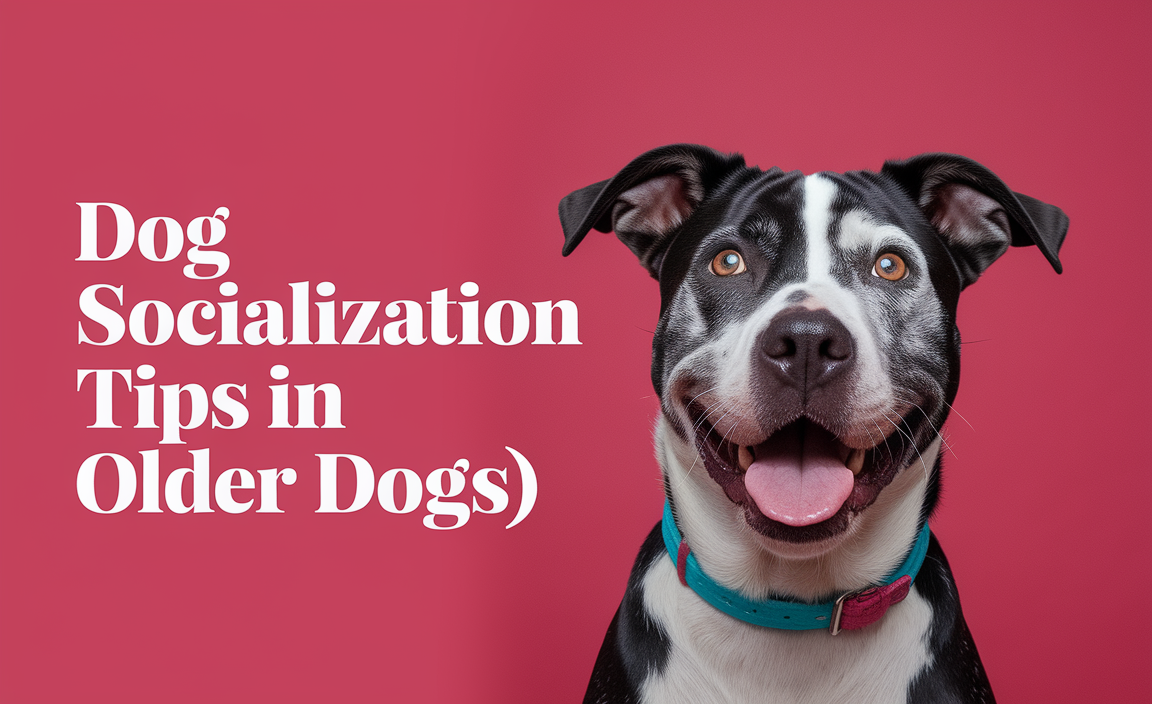Dog pack mentality advice focuses on understanding your dog’s natural social instincts and leading your home with consistent, clear, and positive communication. By establishing yourself as a calm, confident leader, you build a stronger bond and ensure a happier, more harmonious life for both you and your canine companion.
Ever feel like your dog is playing you like a fiddle? Sometimes, it seems like they have their own agenda, and yours just doesn’t make the cut. You’re not alone! Many dog parents wonder about their dog’s behavior, especially when it comes to things like jumping, resource guarding, or barking. A lot of this can be understood through what’s often called “dog pack mentality.” It sounds complicated, but it’s really about understanding how dogs naturally interact and looking at your relationship with your dog through that lens. Don’t worry, we’re going to break down these concepts into super simple, manageable steps. Get ready to feel more confident and connected with your furry best friend!
Understanding “Dog Pack Mentality”: Moving Beyond Myths
The term “dog pack mentality” can sometimes bring to mind images of wolves in the wild or aggressive dominance struggles. While understanding their wild ancestors gives us clues, it’s important to clarify what this means for our beloved pets living in our homes. For most domestic dogs, their “pack” is their human family. They look to us for guidance, security, and resources, much like they would in a natural pack setting. The key here isn’t about “domination” but about clear communication, leadership, and creating a predictable, safe environment.
Older views suggested owners needed to be the “alpha” and constantly assert dominance. Thankfully, modern understanding of canine behavior, backed by research from institutions like the American Veterinary Medical Association (AVMA), shows us a more compassionate and effective approach. It’s less about being the boss and more about being a reliable, consistent, and loving leader. This means setting boundaries, providing clear expectations, and reinforcing good behavior through positive reinforcement.
Why This Matters for You and Your Dog
Understanding this social dynamic helps you:
- Solve common behavioral issues: Many unwanted behaviors stem from a lack of clear leadership or understanding of boundaries.
- Build a stronger bond: When your dog trusts you to provide structure and safety, your relationship deepens.
- Create a harmonious home: A well-understood dog is generally a happier, calmer, and more well-behaved dog.
- Feel more confident as a pet parent: Knowing how to guide your dog reduces stress and makes everyday life more enjoyable.
Essential Steps to Establishing Clear Leadership (The Dog-Friendly Way!)
Forget the outdated “alpha roll” techniques. True leadership in a dog’s eyes comes from consistency, fairness, and positive reinforcement. Let’s dive into actionable steps:
Step 1: Master the Art of Consistent Rules
Dogs thrive on predictability. When rules change without warning, or if different family members enforce them differently, it creates confusion and anxiety for your dog. Be clear about what’s allowed and what isn’t, and make sure everyone in the household is on the same page.
- What to be consistent about:
- Where they are allowed to sleep.
- Whether they can get on furniture.
- Table scraps (generally, a firm “no” here is best for their health!).
- Leash manners.
- Commands like “sit,” “stay,” and “come.”
Example: If your dog isn’t allowed on the couch, this rule should apply every single time, from every single person, regardless of how cute they look.
Step 2: Implement Structured Meal & Resource Management
In natural packs, resources like food are often managed by the leader. You can translate this to your home by controlling your dog’s access to their meals and favorite toys. This doesn’t mean withholding, but rather presenting these resources in a controlled, predictable way.
- Food rituals: Make your dog sit and wait before their food bowl is placed down. This simple act reinforces that you control the valuable resource of food and they must wait for permission.
- Toy management: Don’t leave all their toys out all the time. Rotate them, or only offer certain toys during supervised play. This can help prevent resource guarding issues and make toys more exciting.
- “Leave It” command: Teach your dog to ignore tempting items they shouldn’t have. This is a vital safety command and shows them you are in control of what they interact with.
External Resource: For more on teaching the “Leave It” command, check out guides from reputable organizations like the Humane Society of the United States, which offer excellent, science-based training advice.
Step 3: Prioritize Calm, Confident Communication
Dogs are masters at reading body language and energy. If you’re anxious, stressed, or overly excited, your dog will pick up on it. Your calm, confident demeanor is one of your most powerful tools.
- Your posture: Stand tall, move with purpose, and avoid rushing or yelling.
- Your tone of voice: Use a clear, calm, and firm voice for commands, and a happy, encouraging tone for praise.
- Eye contact: Use gentle, consistent eye contact when giving commands, but avoid prolonged stares that can be interpreted as confrontational.
Tip: If you’re feeling frustrated, take a moment to breathe deeply before interacting with your dog. Your calm energy will help them remain calm too.
Step 4: Establish Clear Boundaries and Personal Space
Just like humans, dogs need to know boundaries. This includes their personal space and the boundaries of the home. Leading your dog establishes these limits respectfully.
- Entry and Exit: Have your dog wait before you open the door for visitors or before they go outside. This teaches them patience and that they don’t rush ahead.
- Passing through doorways: Ask your dog to wait or sit before you pass through doorways. This shows them you lead the way.
- Personal space: Teach your dog not to jump on people and to respect your personal space when you are eating or relaxing.
A note on jumping: If your dog jumps, calmly turn away from them, cross your arms, and wait for all four paws to be on the floor. Only then should you offer attention. Consistency is key!
Step 5: Implement Positive Reinforcement and Reward-Based Training
This is where the “friendly” in friendly leadership comes in! Dogs learn best when they are rewarded for good behavior. This builds positive associations with training and with you.
- Rewards: Use high-value treats, enthusiastic praise, or favorite toys to reward desired actions.
- Timing: Reward immediately (within 1-2 seconds) after the desired behavior occurs so your dog understands exactly what they’re being rewarded for.
- “Marker” signals: Consider using a clicker or a consistent verbal marker word (like “Yes!”) the moment your dog performs the correct behavior, followed by the reward. This clarifies precisely when they did the right thing.
Research shows that positive reinforcement is not only humane but also highly effective. Organizations like the Karen Pryor Academy are excellent resources for learning more about clicker training and positive methods.
Step 6: Provide Sufficient Mental and Physical Stimulation
A tired dog is a good dog! Ensuring your dog has enough exercise and mental challenges is crucial. Boredom can lead to destructive behaviors and anxiety, undermining even the best leadership. “Pack leaders” ensure their pack members are well-cared for.
- Physical Exercise: Daily walks, runs, fetch sessions, or trips to the dog park are essential. Tailor the amount and intensity to your dog’s breed, age, and health.
- Mental Stimulation: Puzzle toys, training sessions, scent games (hide treats around the house and have them find them), and learning new tricks keep their minds engaged.
- Socialization: Safe and positive interactions with other dogs and people can also be stimulating and beneficial.
Tip: A 30-minute vigorous walk plus a 10-minute training session can make a world of difference in a dog’s overall behavior.
Step 7: Manage Your Dog’s Environment and Social Interactions
Setting up your home and social outings for success is key. It’s about preventing opportunities for unwanted behaviors and promoting calm, appropriate interactions.
- When you can’t supervise: Use crates, baby gates, or tethering to give your dog a safe space and prevent them from practicing undesirable behaviors when you’re not watching.
- Visitors: If your dog gets overly excited or anxious with guests, have them on a leash or behind a gate initially. Greet guests calmly, and only allow your dog to interact once everyone is settled.
- Leash walks: If your dog pulls excessively or reacts to other dogs, practice loose-leash walking in quieter areas first. Consider a front-clip harness for better control.
Table: Common Situations & Leadership Solutions
| Situation | Leadership Approach | Why it Works |
|---|---|---|
| Dog jumps up when greeting | Turn away, cross arms, ignore. Reward when all four paws are on the floor. | Removes attention for unwanted behavior, rewards desired behavior. Teaches that calm greetings get rewarded. |
| Dog begs at the table | No table scraps. Ensure they are fed before or after you. Use a “place” command if needed. | You control the food; dog learns to wait patiently and not expect human food. |
| Dog barks excessively at the door/window | Teach “quiet” command. Manage environment (curtains, white noise) to reduce triggers. | Dog learns to defer to you for what to bark at and that you can help manage threats. |
| Dog rushes out of doors | Dog must wait or sit for permission to pass through any doorway. | Reinforces that you lead the way and they must wait for your signal. |
| Dog guards resources (food, toys) | Teach “leave it.” Trade for higher-value treats. Ensure fair play and no teasing. | Builds trust that you won’t unfairly take their prized possessions and that you can manage these items. |
Common Misconceptions About Dog Pack Mentality
It’s easy to get caught up in old myths. Let’s clear them up:
- Myth: You must be the “alpha” and show dominance.
Reality: Modern science shows that calm, consistent leadership and positive reinforcement are far more effective and build a better relationship than dominance-based methods. The American Veterinary Society of Animal Behavior (AVSAB) has stated concerns about dominance-based training for years. - Myth: A dog’s “pack leader” status is fixed from puppyhood.
Reality: While some dogs may be more naturally assertive, our relationship with them is dynamic. Consistent leadership from us can help any dog feel secure and understand their place within the family structure. - Myth: Ignoring bad behavior will make it stop.
Reality: While ignoring attention-seeking behaviors can work if that’s the only goal, often, bad behavior is driven by other factors like fear, anxiety, or boredom. Addressing the root cause and redirecting to good behavior is usually more effective. - Myth: My dog sees me as their “owner,” not their leader.
Reality: The distinction is subtle but important. “Owner” implies possession, whereas “leader” implies responsibility, guidance, and trust – all of which are essential for a healthy canine-human partnership.
FAQs About Dog Pack Mentality Advice
Q1: Is “pack mentality” only for dogs with aggressive tendencies?
A1: Not at all! Understanding your dog’s social instincts helps with all dogs, whether they’re perfectly behaved or struggling with some issues. It’s about clear communication and building a strong, trusting relationship.
Q2: My dog seems to ignore me sometimes. Does this mean they don’t see me as the leader?
A2: Often, ignoring commands can be due to them not fully understanding what’s being asked, being distracted, or lacking motivation. It’s less about their “view” of your leadership and more about clarifying your communication and making training more rewarding.
Q3: What if my family members don’t agree on the rules?
A3: This is a common challenge! It’s crucial to have a family meeting and decide on consistent rules together. Everyone needs to be on the same page for your dog not to get confused. Your dog’s well-being should be the priority.
Q4: Is it okay for my dog to sleep on the bed with me if I’m the “leader”?
A4: Absolutely. Sleeping arrangements are a personal choice for the family. If everyone agrees and it doesn’t lead to resource guarding or anxiety, it’s fine. The key is consistency in your rules, whatever they may be.
Q5: I rescued a dog with an unknown history. How can I establish leadership with them?
A5: Start with patience and consistency. Focus on basic obedience, positive reinforcement, and building trust. Slowly introduce rules and routines. Building a strong, positive relationship is the best way to help any dog, especially those with a past.
Q6: How do I handle resource guarding without using dominance?
A6: Avoid confronting your dog directly when they’re guarding. Instead, focus on teaching them that good things happen when you approach. Trade them for something better, use the “leave it” command, and ensure they have plenty of their own space and items.
Building a Confident, Connected Partnership
Understanding dog “pack mentality” isn’t about harsh corrections or proving you’re the boss. It’s about recognizing your dog’s natural instincts and leveraging that knowledge to create a clear, consistent, and loving environment. By implementing these simple, positive steps, you’re not just teaching your dog rules; you’re building a profound bond based on trust and mutual respect.
Remember, every interaction is an opportunity to communicate. Whether it’s a quick “sit” before a meal, a calm greeting at the door, or a fun training session, you are consistently showing your dog that you are their reliable guide. This clarity reduces stress for both of you, leading to a happier, more harmonious life together. You’ve got this, and your dog will thank you for it!
Meet Elyse Colburn, the devoted canine companion and storyteller behind the enchanting world of “Tales, Tails, and Adventures Unleashed.” A passionate dog enthusiast with a heart full of paw prints, Elyse Colburn shares heartwarming tales and insightful adventures, celebrating the joy, loyalty, and endless antics that make every dog a true hero. Join Elyse Colburn on this tail-wagging journey, where every post is a love letter to our four-legged friends.







